Join us for conversations that inspire, recognize, and encourage innovation and best practices in the education profession.
Available on Apple Podcasts, Spotify, Google Podcasts, and more.
Look for the following topics in the video, indicated by the ![]() onscreen icon, and click below to learn more.
onscreen icon, and click below to learn more.
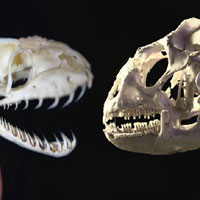 Classifying Reptiles |
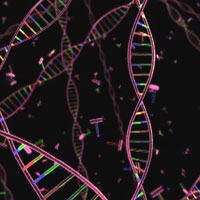 Identifying Species |
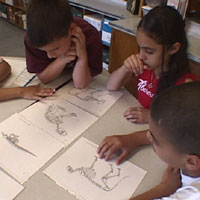 Vertebrate Evolution |
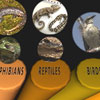 Building a Tree of Life |
 Scientist at Work |
Curriculum Resources |

Snake and lizard skulls
In the video, Dr. Jim Hanken shared part of the collection of reptiles stored at the Museum of Comparative Zoology (MCZ) at Harvard University. The specimens he showed us are part of a vast collection of reptiles and amphibians, the study of which is called herpetology, from the Greek word “herpeton,” meaning “creeping thing.” Historically, reptiles and amphibians have been grouped together. Fossil and other evidence conclusively shows that reptiles evolved from an amphibian-like ancestor. However, the features that distinguish reptiles from amphibians show that they are very different. These features reflect a transition from an aquatic life to life on land.

Reptiles are part of the domain Eukarya, which includes all organisms that have cells with a nucleus. They are included in the kingdom Animalia, with other organisms that are multicellular, ingest food, and have cells that lack cell walls. Further classification places them in the phylum Chordata. Chordates have a nerve cord running along the lengths of their backs (e.g., our spinal cord). As chordates with backbones, they are placed in the subphylum Vertebrata. Reptiles form the class Reptilia.
There are four existing orders of reptiles, including turtles, crocodiles and alligators, lizards and snakes, and tuataras. Dr. Hanken focused on comparisons between members in the class that includes lizards and snakes, showing evidence that snakes evolved from lizards. Recent advances in classification methods have determined that birds arose from a group of dinosaurs — as a result, they will likely be re-classified as an order within the reptiles.
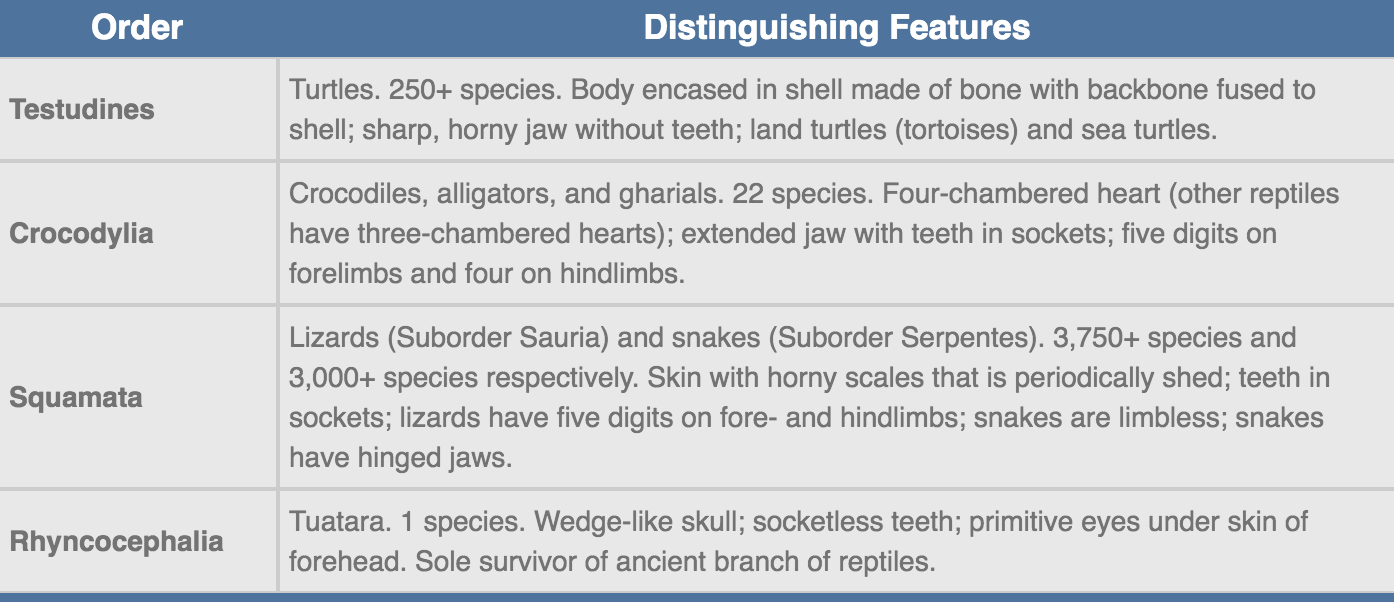
The simplest answer to this question is that a species is a “type” of organism. We all recognize that there is a “boundary” that separates dogs from chimpanzees and chimpanzees from human beings, for example. For centuries, scientists distinguished one species from another by observable differences in external and internal features. Because different species can look nearly identical, and even members of the same species can look very different, behavior became an important clue. The ability to reproduce together was a key behavior used to determine species boundaries. This still generally holds true for organisms that reproduce sexually, although crossbreeding between species does occur in the natural world. This classification method is becoming outdated, however, as advances in DNA sequencing occur.

Model of DNA
The genome of a species is considered to be unique to that species. The genome exists as segments of DNA in an organism’s cells — the 46 chromosomes in human cells, for example. Comparisons of segments of DNA that represent genes reveal how similar two organisms are. Scientists now use differences in DNA sequences as a more precise way of distinguishing among species and to propose their evolutionary relationships. At the simplest level, the degree of difference implies the degree of divergence from a common ancestor and thus allows the investigator to infer the relatedness among species. The assumption is that as two species diverge from one, their genomes will become more and more different. Using this assumption with DNA sequencing, chimpanzees and humans are inferred to be more closely related to each other than either are to dogs because their DNA is more similar.
The analysis of DNA sequencing still involves debate and varying practices. Differences in the DNA between separate species of mammals can be slight: Humans, for example, share 99.6% of their DNA with chimpanzees. For bacteria, however, current practice requires a 3% or greater DNA difference to constitute a separate species. It is easy to imagine how the diversity of bacteria could be easily underestimated by this practice — and bacteria are probably the most diverse group of organisms on the planet.

The vertebrate branch of the “tree of life”
The animal kingdom is typically divided into two main groups: the invertebrates and the vertebrates. The vertebrates are distinguished by the presence of a backbone, and are the organisms that come to mind when one thinks of an animal: fish, amphibians, reptiles, birds, and mammals.
The invertebrates, however, represent a vast number of species, which are classified into phyla that include:
The invertebrates are worth mentioning because they represent the evolutionary history of the vertebrates. The vertebrates are a relatively recent “branch” on the tree of life and retain features of almost every invertebrate group. Some people find it intriguing that, of the invertebrates, our closest relatives are starfish and sea urchins.
The vertebrates are actually a subphylum within the phylum Chordata. Chordates are characterized by having a nerve cord running along the length of the back. While there are a few invertebrate chordates, the vertebrates are noted for having an endoskeleton (endo = internal), which includes the backbone. Interestingly, not all vertebrates have backbones — or skeletons — made of bone. More primitive forms, like sharks and rays, have skeletons made entirely of cartilage.
When scientists describe vertebrate evolution, they most often frame it as a transition from water to land. Once on land, the vertebrates are described as evolving to occupy diverse habitats and live very active lifestyles. What are some of the adaptations that made these transitions possible?
Jaws: The earliest vertebrates in evolutionary history are the fish. The earliest fish had no jaws — they sucked and rasped flesh of their prey rather than biting it. These fish include hagfish and lampreys. Fish that arose later, including the sharks and the bony fish, have jaws. Jaws represent a much more efficient and effective mode of capturing, feeding on, and swallowing prey.
Lungs and limbs: In order for vertebrates to succeed on land, they had to be able to breathe and move around. These adaptations are first seen in a primitive group of fish, of which a living example exists — the lungfish. Although they take in oxygen primarily through gills, they also have lungs. Their fleshy fins are supported by bone, and they can walk around in their habitats. The amphibians are thought to have evolved from fish like this. As their name implies – “amphibian” comes from the Greek word “amphibious,” meaning “double life” – the adaptations of amphibians truly reflect mixed habitats.
Watertight skin and eggs: To live exclusively on land requires the ability to avoid water loss. The next adaptations in vertebrate evolution included skin that acts as a watertight barrier. Evolving from amphibians, the reptiles are the first vertebrate group to show this adaptation. Reptiles also have what is called an amniote egg. Amniote eggs contain their own water supply and are surrounded by a leathery or hard shell. Birds, which are known to have evolved from reptiles, also have amniote eggs. Their feathers are actually modified scales.
Endothermy: Birds and mammals possess an adaptation known as endothermy (endo = internal; therm = temperature). This is what we typically call “warm-bloodedness..” This occurs as body temperature is regulated internally using heat supplied by the burning of food for fuel. Endothermy permits a degree of independence from environmental conditions. With this adaptation, birds and mammals have further evolved to possess diverse ways of feeding, avoiding predators, finding suitable habitats, and reproducing.
In the video, Dr. Douglas Zook noted an important idea. Often, people think of vertebrate evolution as being “ladder-like,” where earlier forms are replaced and improved upon by more modern forms. This isn’t how vertebrate evolution occurred. From common ancestors, each group branched into their own successful lineages. The most primitive living fish is just as successful in an evolutionary sense as the most recently evolved mammal — the human being.
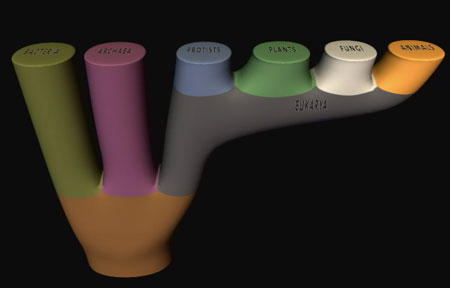
A tree of life
The theory of evolution by natural selection makes a powerful supposition: All species, past and present, trace their ancestry to a single common ancestor. If this is valid, and if evidence of common ancestry can be found, scientists should be able to trace the evolution of life on Earth. A tree of life is a powerful graphic model that is used to display this information.
To interpret a tree of life is simple. Every node represents a common ancestor, from which two different lineages branch. Branches that occur closer to the top of the tree represent lineages that arose later in evolutionary time. The tips of branches represent living species. The closer two tips are within one branch, the more closely they’re related.
Scientists constructing early trees of life used a variety of data to hypothesize relatedness of modern species – mostly external and internal features. This was supplemented with other types of evidence, including the fossil record. It was (and is) particularly exciting for scientists to find transitional forms, which provide evidence of common ancestry. One notable example is Archaeopteryx, which, preserved as a fossil imprint, has both reptile and bird features, and is used to argue that birds evolved from reptiles.
Today, molecular evidence in the form of DNA sequencing is used to provide data to build a tree of life. The assumption with this type of data is based on mutation — changes in DNA sequences due to errors in replication. Mutation provides the variation upon which natural selection acts in order to cause evolution. As two species evolve from a common ancestor, their DNA will continue to mutate and will become less and less similar. Eventually, differences in DNA become a genetic reflection of the differences between species. DNA sequencing, therefore, is allowing scientists to build a tree of life that they consider to be much more accurate.
 Dr. James Hanken is the director of Harvard University’s Museum of Comparative Zoology, where he also serves as the curator of Herpetology. Additionally, he serves as Alexander Agassiz Professor of Zoology in the Department of Organismic and Evolutionary Biology. Hanken earned his Ph.D. at the University of California at Berkeley, and then worked on the faculty of Colorado State University for 16 years before coming to Harvard in 1999. His research interests include evolutionary biology, especially development, morphology, and systematics, and he works principally with amphibians. Professor Hanken oversees research efforts in Sri Lanka, Africa, and South America, and is currently engaged in his own fieldwork in Central America, where he is interested in describing new species of salamander. In addition to his work as a biologist, Professor Hanken has received awards for his nature and scientific photography.
Dr. James Hanken is the director of Harvard University’s Museum of Comparative Zoology, where he also serves as the curator of Herpetology. Additionally, he serves as Alexander Agassiz Professor of Zoology in the Department of Organismic and Evolutionary Biology. Hanken earned his Ph.D. at the University of California at Berkeley, and then worked on the faculty of Colorado State University for 16 years before coming to Harvard in 1999. His research interests include evolutionary biology, especially development, morphology, and systematics, and he works principally with amphibians. Professor Hanken oversees research efforts in Sri Lanka, Africa, and South America, and is currently engaged in his own fieldwork in Central America, where he is interested in describing new species of salamander. In addition to his work as a biologist, Professor Hanken has received awards for his nature and scientific photography.
 Dr. Douglas Causey is senior biologist at the Museum of Comparative Zoology, Harvard University, and serves as the chief ornithologist in the museum. He has authored more than 120 articles and books on natural history, biodiversity, and ornithology, and is actively engaged in research and public education. His research is focused on the co-evolution and natural history of avian viruses, tropical biodiversity, and environmental security and sustainability. He has active research programs in the United States, throughout the Arctic, and Central and South America. At present, he is undertaking a broad-scale survey of birds and avian disease pathogens along migration pathways ranging from Arctic Siberia and Alaska to both coasts of Costa Rica. He has been working for the past decade on various issues relating to national and international environmental policy, and has published several recent articles on environmental security and the conservation of forests and biodiversity.
Dr. Douglas Causey is senior biologist at the Museum of Comparative Zoology, Harvard University, and serves as the chief ornithologist in the museum. He has authored more than 120 articles and books on natural history, biodiversity, and ornithology, and is actively engaged in research and public education. His research is focused on the co-evolution and natural history of avian viruses, tropical biodiversity, and environmental security and sustainability. He has active research programs in the United States, throughout the Arctic, and Central and South America. At present, he is undertaking a broad-scale survey of birds and avian disease pathogens along migration pathways ranging from Arctic Siberia and Alaska to both coasts of Costa Rica. He has been working for the past decade on various issues relating to national and international environmental policy, and has published several recent articles on environmental security and the conservation of forests and biodiversity.
Insights is an elementary hands-on inquiry science program designed to develop children’s understanding of key concepts and to improve students’ abilities to think creatively and critically. Insights also encourages problem solving and integrates science with the rest of the curriculum.
The Insights curriculum is made up of 17 modules, each of which contains 12 to 20 “learning experiences” (hands-on, inquiry activities) in which teachers guide students as they explore new concepts. Throughout the modules, six major science themes are represented: systems, change, structure and function, diversity, cause and effect, and energy.
Originally funded by a grant from the National Science Foundation, the Insights program was developed by science education specialists at Education Development Center, Inc. For more information, contact:
Kendall/Hunt Publishing Company
1-800-542-6657
http://www.kendallhunt.com/